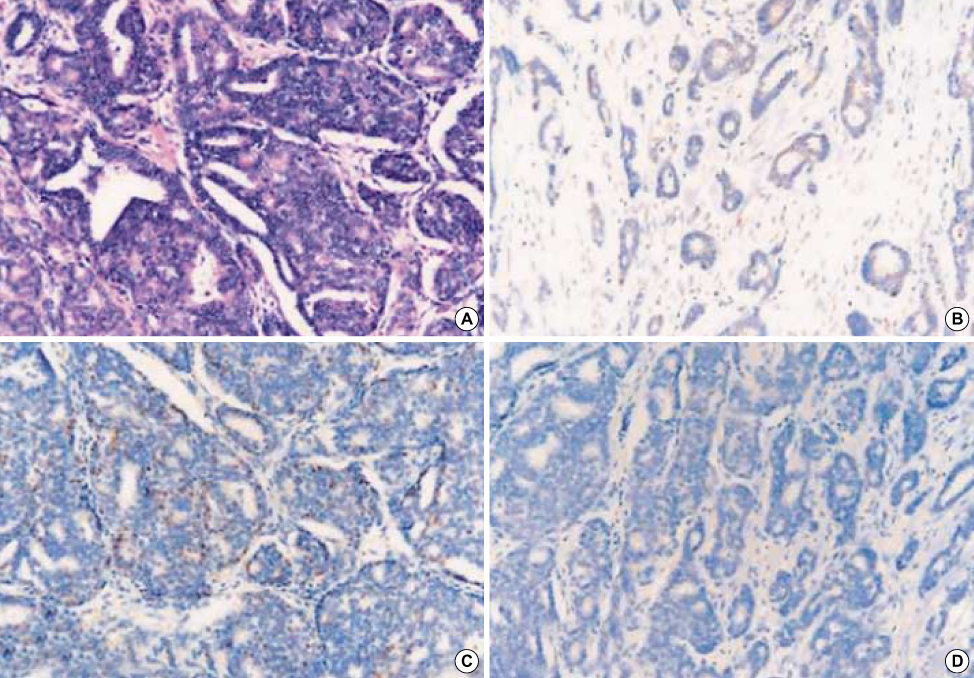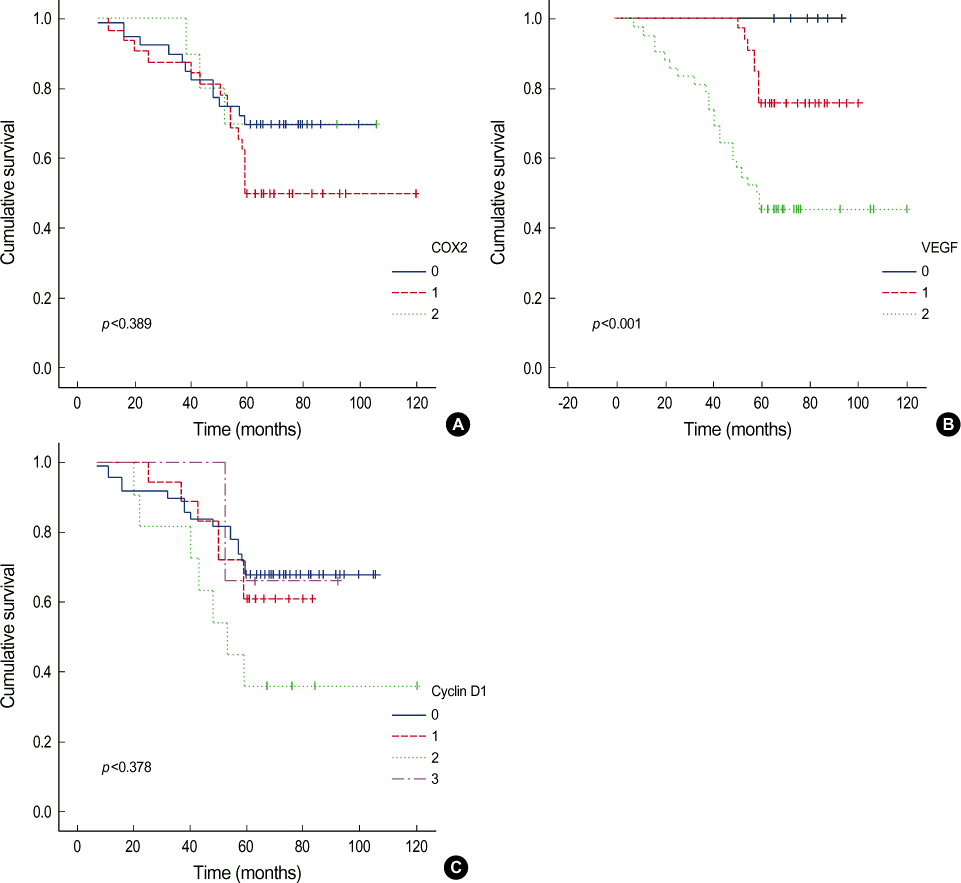J Breast Cancer.
2007 Mar;10(1):10-18. 10.4048/jbc.2007.10.1.10.
Prognostic Significance COX-2, VEGF and Cyclin D1 in Distant Metastasis of Breast Cancer
- Affiliations
-
- 1Department of Surgery, Chungnam National University Hospital, Daejeon, Korea. leejin123@hanmail.net
- KMID: 2174996
- DOI: http://doi.org/10.4048/jbc.2007.10.1.10
Abstract
-
PURPOSE: The most important independent prognostic factors of breast cancer have been reported to the tumor size and lymph node metastasis, as well as DNA ploidy, proliferation index, and various receptors, including estrogen receptor (ER) and progesteron receptor (PR) and oncogenes, such as c-erbB-2, and the tumor suppressor gene, p53. However, all these prognostic factors are still unable to exactly estimate distant metastasis for breast cancer. Based on this, our aim was to study for the prognostic factors that associated distant metastasis of breast cancer with cyclooxygenase-2 (COX-2) and vascular endothelial growth factor (VEGF), which are related to angiogenesis, and Cyclin D1, which participates in cell proliferation in breast cancer.
METHODS
A retrospective study was carried out on 95 patients, who has undergone an operation for breast cancer, with or without metastasis between January 1993 and July 2001, at the Department of Surgery, Chungnam National University Hospital. The study was based on the immunohistochemical staining of primary tumors for COX-2, VEGF, Cyclin D1, ER, PR and c-erbB-2, which were obtained from tissue samples of 45 and 50 patients with and with no distant metastatic breast cancer. SPSS for Windows, Version 10.0 was used for the statistical analyses.
RESULTS
The expressions of COX-2, VEGF and Cyclin D1 were statistically significant in distant metastatic breast cancer. The clinicopathological parameters associated with distant metastasis were the tumor size and histological grade, and lymph node metastasis, lymphovascular invasion, ER and PR. There were positive correlations between 1) COX-2 and VEGF, 2) COX-2 and Cyclin D1, 3) c-erbB-2 and Cyclin D1 and 4) VEGF and Cyclin D1, COX-2 also had positive relationships with the tumor size and c-erbB-2, VEGF had positive relationships with lymph node metastasis, histological grade and lymphovascular invasion, as well as with ER and PR. The overexpressions of COX-2, VEGF and Cyclin D1 shortened the disease-free survival and survival period.
CONCLUSION
The overexpressions of COX-2, VEGF and Cyclin D1 were considered poor prognostic factors for the induction of distant metastasis. Therefore, COX-2, VEGF and Cyclin D1 could be used in the prevention of distant metastasis, and prescribed for the treatment of metastatic breast cancer.
Keyword
MeSH Terms
-
Breast Neoplasms*
Breast*
Cell Proliferation
Chungcheongnam-do
Cyclin D1*
Cyclins*
Cyclooxygenase 2
Disease-Free Survival
DNA
Estrogens
Genes, Tumor Suppressor
Humans
Lymph Nodes
Neoplasm Metastasis*
Oncogenes
Ploidies
Retrospective Studies
Vascular Endothelial Growth Factor A*
Cyclin D1
Cyclins
Cyclooxygenase 2
DNA
Estrogens
Vascular Endothelial Growth Factor A
Figure
Reference
-
1. Lim SC. Role of COX-2, VEGF and cyclin D1 in mammary infiltrating duct carcinoma. Oncology Reports. 2003. 10:1241–1249.
Article2. Wülfing P, Diallo R, Müller C, Wülfing C, Poremba C, Heinecke A, et al. Analysis of cyclooxygenase-2 expression in human breast cancer high throughout tissue microarray analysis. J Cancer Res Clin Oncol. 2003. 129:375–382.3. Ristmäki A, Sivula A, Lundin J, Lundin M, Salminen T, Haglund C, et al. Prognostic significance of elevated cyclooxygenase-2 expression in breast cancer. Cancer Res. 2002. 62:632–635.4. Ben-Av P, Crofford LJ, Wilder RL, Hla T. Induction of vascular endothelial growth factor expression in synovial fibroblasts by prostaglandin E and interleukin-1: a potential mechanism for inflammatory angiogenesis. FEBS Lett. 1995. 372:83–87.
Article5. Goodwin JS, Ceuooens J. Regulation of the immune response by prostaglandins. J Clin Immuno. 1983. 3:295–314.
Article6. Rolland PH, Martin PM, Jacquemier J, Rolland AM, Toga M. Prostaglandin in human breast cancer: evidence suggesting that an elevated prostaglandin production is a marker of high metastatic potential for neoplastic cells. J Natl Cancer Inst. 1980. 64:1061–1070.7. Tsujii M, DuBois RN. Alterations in cellular adhesion and apoptosis in epithelial cells overexpressing prostaglandin endoperoxide synthase 2. Cell. 1995. 83:493–501.
Article8. Costa C, Soares R, Reis-Filho JS, Leitao D, Amendoeira I, Schmitt FC. Cyclo-oxygenase 2 expression is associated with angiogenesis and lymph node metastasis in human breast cancer. J Clin Pathol. 2002. 55:429–434.
Article9. Senger DR, Van de Water L, Brown LF, Nagy JA, Yeo KT, Yeo TK, et al. Vascular permeablilty factor (VPF, VEGF) in tumor biology. Cancer Metastsis Rev. 1993. 12:303–324.10. Kenny FS, Hui R, Musgrove EA, Gee JM, Blamey RW, Nicholson RI, et al. Overexpression of cyclin D1 messenger RNA predicts for poor prognosis in estrogen receptor-positive breast canccer. Clin Cancer Res. 1999. 5:2069–2076.11. Lebeau A, Unholzer A, Amann G, Kronawitter M, Bauerfeind I, Sendelhofert A, et al. EGFR, HER-2/neu, Cyclin D1, p21 and p53 in correlation to cell proliferation and steroid hormone receptor status in ductal carcinoma in situ of the breast. J Cancer Res Clin Oncol. 1999. 125:8–9.
Article12. Hwang TS, Han HS, Hong YC, Lee HJ, Paik NS. Prognostic value of combined analysis of Cyclin D1 and estrogen receptor status in breast cancer patients. Pathol Int. 2003. 53:74–80.
Article
- Full Text Links
- Actions
-
Cited
- CITED
-
- Close
- Share
- Similar articles
-
- Study of the Relationships between Cyclin D1 and Known Prognostic Factors in Breast Cancer
- Significance of Expression of bcl-2, p53 and cyclin D1 and Their Correlation with Clinicopathologic Prognostic Factors and Survival Rate in 128 Cases of Invasive Breast Carcinoma
- Expression of Cyclin D1 Protein in Breast Cancer and Its Correlation with Prognosis
- The Clinical Significance of Cyclin D1 and p16 Protein Expression in Primary Breast Carcinoma
- The Influence of Expressions of Cyclin B1 and D1 on Clinicopathologic Prognostic Factors and Survival Rate in Gastric Cancer





